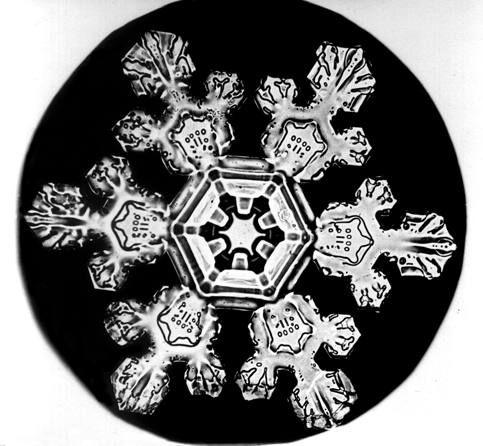 Ever wonder just why no two snowflakes are alike? Read on!
Ever wonder just why no two snowflakes are alike? Read on!
The Makings of a Snowflake
A snowflake is simply a bunch of ice crystals stuck together. Each crystal started as a speck, perhaps a particle of volcanic ash or evaporated ocean salt or even a grain of pollen. As the speck cooled high up in the atmosphere, water vapor stuck to it. Tossed about in the cold air, the speck collects more water vapor, grows bigger and heavier, and begins to fall to earth.
The shape of a snow crystal depends on how wet and cold the air is where the crystal forms. As the crystal falls through the air, its shape and size may change as conditions change. Crystals may collide, clump together, and break apart. Breathe on that snow crystal on your mitten and it will change again, melt, and disappear.
The journey each snowflake takes, falling through rapidly changing conditions, makes it unlikely that any two snowflakes will be exactly alike.
Types of Snowflakes
Each snowflake may be unique, but in 1951 scientists classified types of snowflakes into an international snow classification system. Since then, the system has been revised and new systems have been created, but they all enable us to organize and talk about snow crystals. (Montana State University even offers an undergraduate degree in snow science.)
What types of snow crystals are you likely to see? Crystals shaped like columns, needles, and hexagonal plates generally form under low temperatures, little moisture, and grow slowly. Complex crystals—the beautiful star-shaped crystals we think of as the traditional snowflake—form under higher temperatures and humidity. The type of snow crystal that falls will often determine whether a snowfall is sticky, slippery, powdery, or good for snow building.
Seeing Snowflakes
Wilson Bentley, born in 1865 in Jericho, Vermont, devoted his entire life to studying and photographing snowflakes. His gorgeous photos, first published in 1931, are still studied by scientists and available to the public in Snow Crystals reprinted by Dover Publications. Bentley’s contributions are immortalized in a museum and monument in Jericho and in a lovely children’s book, Snowflake Bentley, by Jacqueline Briggs Martin.
So when it starts to snow and it’s safe to go outside, channel your inner Bentley and go snowflake watching. Here’s how:
- First, locate a dark surface. Simple household objects—a black scarf, a piece of black construction paper, or a dark baking tray—work fine.
- Next, take your dark surface outside, cool it to air temperature, and then hold it out flat to catch some falling snowflakes.
- Take a look at what you capture, but be careful not to breathe on the flakes or they will melt and disappear. A magnifier will bring out the details.
Enjoy and learn more about snow during a Mass Audubon program this winter. And please stay safe during the storm!
Photo: Wilson Bentley Snowflake via snowflakebentley.com


Years ago a Photo Workshop participant in Arcadia’s Nature Digital class brought in an image of a snowflake. We were all blown away.